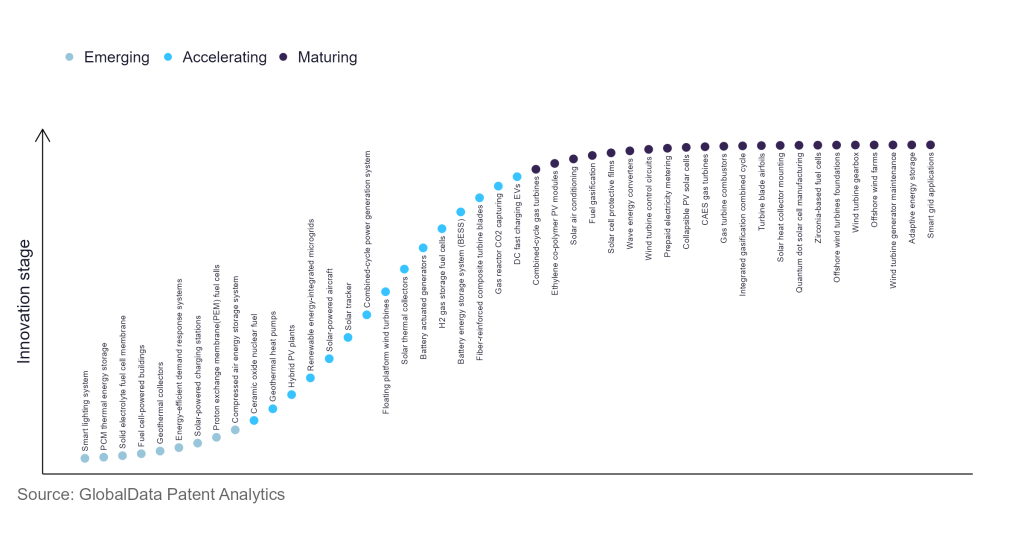The power industry continues to be a hotbed of innovation, with activity driven by the growth in renewable generation, need for improved efficiency and reduction in greenhouse gas emissions, and growing importance of technologies such as energy storage. In the last three years alone, there have been over 439,000 patents filed and granted in the power industry, according to GlobalData’s report on Environment Sustainability in Power: Compressed air energy storage system. Buy the report here.
However, not all innovations are equal and nor do they follow a constant upward trend. Instead, their evolution takes the form of an S-shaped curve that reflects their typical lifecycle from early emergence to accelerating adoption, before finally stabilising and reaching maturity.
Identifying where a particular innovation is on this journey, especially those that are in the emerging and accelerating stages, is essential for understanding their current level of adoption and the likely future trajectory and impact they will have.
90+ innovations will shape the power industry
According to GlobalData’s Technology Foresights, which plots the S-curve for the power industry using innovation intensity models built on over 83,000 patents, there are 90+ innovation areas that will shape the future of the industry.
Within the emerging innovation stage, smart lighting system, PCM thermal energy storage, and solid electrolyte fuel cell membrane are disruptive technologies that are in the early stages of application and should be tracked closely. Ceramic oxide nuclear fuel, geothermal heat pumps, and hybrid PV plants are some of the accelerating innovation areas, where adoption has been steadily increasing. Among maturing innovation areas are combined-cycle gas turbines and ethylene co-polymer PV modules, which are now well established in the industry.
Innovation S-curve for environmental sustainability in the power industry

Compressed air energy storage system is a key innovation area in environmental sustainability
Compressed air energy storage (CAES) is a technology of storing electrical energy generated during periods of surplus supply and making it accessible again during times of high demand. Electrical energy is utilised in a CAES system to compress air, which is then stored in an underground reservoir and back produced using energy recovered in a gas turbine.
GlobalData’s analysis also uncovers the companies at the forefront of each innovation area and assesses the potential reach and impact of their patenting activity across different applications and geographies. According to GlobalData, there are 20+ companies, spanning technology vendors, established power companies, and up-and-coming start-ups engaged in the development and application of compressed air energy storage system.
Key players in compressed air energy storage system – a disruptive innovation in the power industry
‘Application diversity’ measures the number of different applications identified for each relevant patent and broadly splits companies into either ‘niche’ or ‘diversified’ innovators.
‘Geographic reach’ refers to the number of different countries each relevant patent is registered in and reflects the breadth of geographic application intended, ranging from ‘global’ to ‘local’.
Patent volumes related to compressed air energy storage system
| Company | Total patents (2021 - 2023) | Premium intelligence on the world's largest companies |
| Kobe Steel | 79 | Unlock Company Profile |
| LightSail Energy | 43 | Unlock Company Profile |
| State Grid Corporation of China | 24 | Unlock Company Profile |
| Wobben Properties | 23 | Unlock Company Profile |
| Johnson Controls International | 19 | Unlock Company Profile |
| Siemens | 18 | Unlock Company Profile |
| Ingeteam Corporacion | 15 | Unlock Company Profile |
| Next Hydrogen | 13 | Unlock Company Profile |
| Hitachi | 13 | Unlock Company Profile |
| China Southern Power Grid | 12 | Unlock Company Profile |
| Storelectric | 8 | Unlock Company Profile |
| PowiDian | 8 | Unlock Company Profile |
| Basic Holdings | 8 | Unlock Company Profile |
| International Business Machines | 7 | Unlock Company Profile |
| Acciona | 7 | Unlock Company Profile |
| Airbus | 7 | Unlock Company Profile |
| Toshiba | 6 | Unlock Company Profile |
| Denso | 6 | Unlock Company Profile |
| Schlumberger | 6 | Unlock Company Profile |
| CEA | 6 | Unlock Company Profile |
| China Energy Investment | 5 | Unlock Company Profile |
| AMETEK | 5 | Unlock Company Profile |
Source: GlobalData Patent Analytics
Siemens is one of the leading patent filers in compressed air energy storage systems. Siemens, a world leader in power generation, with a broad portfolio and global installed base of thousands of utility- and industrial-grade gas turbines and compressors, is at the forefront of CAES technology. Back in 1991, a McIntosh 110 MW CAES plant in Alabama, was built with Siemens Energy technology. Recently, Siemens has signed an agreement to collaborate with Corre Energy, a European company focused on long-duration energy storage based on compressed air technology.
In terms of application diversity, Kobe Steel, Ingeteam, and Acciona are some of the leading players in compressed air energy storage systems. Based on geographic reach, State Grid Corporation of China, Hitachi, China Southern Power Grid, Toshiba and Schlumberger are some of the leading patent filers in compressed air energy storage systems.
To further understand the key themes and technologies disrupting the power industry, access GlobalData’s latest thematic research report on Power.
Data Insights
From

The gold standard of business intelligence.
Blending expert knowledge with cutting-edge technology, GlobalData’s unrivalled proprietary data will enable you to decode what’s happening in your market. You can make better informed decisions and gain a future-proof advantage over your competitors.



